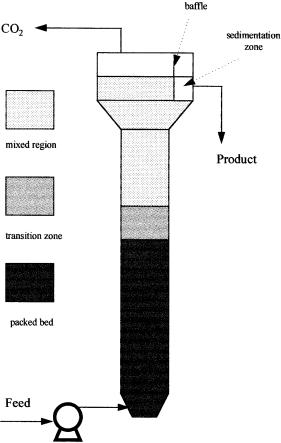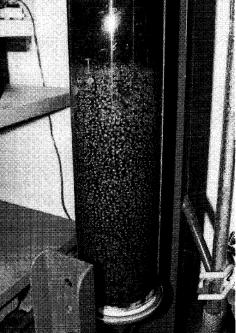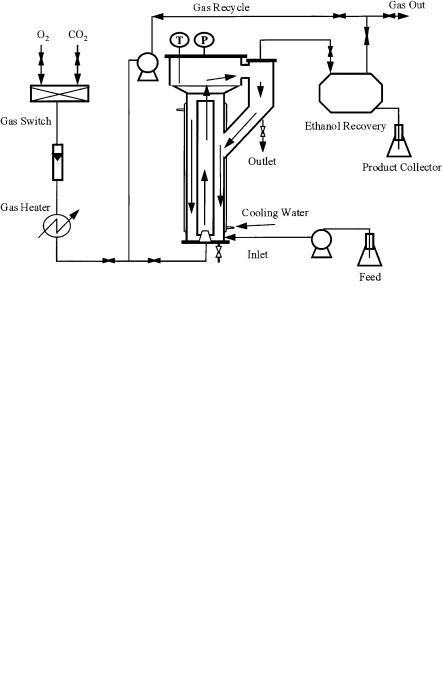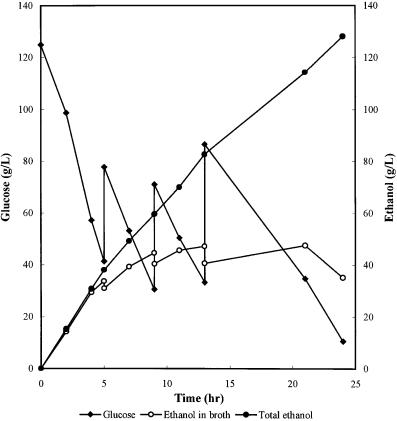
Recent Progress in Bioconversion of Lignocellulosics
.pdfEthanol Production from Renewable Resources |
209 |
Native lignocellulosic materials are heterogeneous, containing cellulose, hemicellulose, lignin, ash, protein, and a wide array of minor extractives. Cellulose is a linear high molecular weight polysaccharide composed of two residues (b- 1,4-linked glucose, known as cellobiose) in repeated units. Complete hydrolysis of cellulose yields the sugar, glucose. On the other hand, hemicellulose has a much lower molecular weight than cellulose. It is a heteropolysaccharide that is composed of various hexoses (e.g. glucose, mannose and galactose), pentoses (D-xylose and L-arabinose), uronic acids, acetic acid, and other minor sugars. By definition, hemicelluloses are short branched chain heteropolysaccharides of mixed hexosans and pentosans that are much easier to convert to their sugar constituents than cellulose.
2
Fermentation of Hexoses
For the efficient conversion of starchy materials to ethanol, productivity is the major concern. Since the primary sugar from starch is glucose, the biocatalyst used is almost exclusively the yeast, Saccharomyces cerevisiae. S. cerevisiae and related species have the ability to utilize a wide range of hexoses such as glucose, fructose, sucrose, galactose, maltose, and maltotriose to produce a high yield of ethanol. In addition, closely related species such as S. uvarum (S. carlsbergensis) and S. distaticus are able to utilize melibiose and starch, respectively. Another microorganism, Zymomonas mobilis, has been considered as an alternative biocatalyst. This bacterium has advantages over S. cerevisiae due to its ability to employ the Entner-Doudoroff pathway anaerobically that converts pyruvate to ethanol and CO2 as the sole means of energy generation (see [1] for review). This pathway yields only one mole of ATP per mole of sugar consumed. In order to compensate for this low energy yield, glucose is metabolized at a very high rate resulting therefore in high ethanol productivity [2, 3].
2.1
Process Improvement
In order to increase productivity, thereby reducing the cost of ethanol fermentation, various alternatives to traditional fermentation techniques, including biocatalyst improvement, have been studied.
2.1.1
Strain Improvement
Various techniques are employed to obtain the improved biocatalysts for potential improvement. These include the following: mutation and selection, hybridization, protoplast fusion, and recombinant DNA methods. One example of strain improvement is the development of an ethanol-tolerant yeast strain, Saccharomyces 1400, through protoplast fusion of S. distaticus and S. uvarum as reported by D’Amore et al. [4]. This yeast strain was used as the biocatalyst by Krishnan et al. [5] for the rapid fermentation of high concentrations of glucose
210 |
C.S. Gong et al. |
to ethanol. It was also used as the host in the creation of a recombinant xylosefermentation yeast strain by Ho and Tsao [6]. Another example of strain improvement is the isolation of the high flocculent yeast strain, S. uvarum U4, by Gong and Chen [7]. This high-ethanol and high-osmotic pressure-tolerant flocculent yeast has been used in a packed yeast column for continuous ethanol fermentation [8–12].
2.1.2
Continuous Ethanol Fermentation
One effective way to increase ethanol productivity is to employ a continuous process using an immobilized biocatalyst. Living cells can be entrapped within porous solid supports, such as calcium alginate, carrageenan or polyacrylamide. Surface adsorption on solid support is another method of cell immobilization that has been widely employed. In surface adsorption, microbial cells are adsorbed onto the surface of wood chips, bricks, synthetic polymers, or other materials that have a large surface area (see [13] for references). Compared to a conventional batch free-cell system, the immobilized cell system has the advantage of being able to maintain a much higher cell density in the fermentor thereby increasing ethanol productivity. Continuous ethanol fermentation can also be carried out in a tower fermentor packed with flocculent yeast cells.
2.1.2.1
Tower Fermentor
Tower fermentors were developed for the beverage industry in the 1960s to provide a continuous fermentation system that would be more productive and efficient than the batch system. Their special feature is the use of a flocculent yeast strain in a narrow vertical tubular reactor. Medium containing both nutrients and substrate flows into the bottom of the fermentor and is fermented as it migrates up through a dense bed of yeast cells. The fermented medium passes through a settler before exiting. The purpose of the settler is to provide a quiescent zone where yeast flocs, buoyed up by carbon dioxide evolution, can settle back into the reactor. Figure 1 shows the configuration of such a fermentor with packed yeast cell aggregates.
For high flocculent yeast strains such as S. uvarum U4, a near solid yeast plug is formed at the lower region of the tower fermentor and above this region lies a mixed zone containing smaller yeast flocs and newly formed yeast particles (Fig. 2). The bed height of the yeast plug, the size of yeast flocs, and the concentration of flocs in the mixed region are the functions of flow rate, CO2 evolution, and substrate density [10]. During fermentation, reactor operation can approach plug flow behavior through the yeast bed, analogous to a fixed-bed reactor. At low flow rates and low CO2 evolution, the mixed section above the plug may be nearly floc-free. On the other hand, very high flow rates and high CO2 production will cause the bed to disintegrate. The reactor then becomes a mixed-flow reactor, analogous to a fluidized-bed reactor [12].

Ethanol Production from Renewable Resources |
211 |
Fig. 1. Schematic configuration of a tower fermentor with S. uvarum [12]
Continuous ethanol fermentation using a tower fermentor with high flocculent yeast strains has been studied in depth (see [13] for pertinent references). Overall, the system has the following characteristics:
(1)A much higher cell concentration (70–100 g dry cell/l) than the immobilized cell system (30–50 g dry cell/l).
(2)Self-maintenance, without need for immobilization.
(3)Highly resistant to contamination due to the very high yeast cell density and the rapid rise in ethanol concentration.
(4)Long-term stability due to the self replenishing of fresh yeast cells.
(5)High ethanol productivity.
(6)No requirement for centrifugation and agitation equipment and, therefore, reduction in labor and maintenance costs.
(7)Lower capital expense due to the higher throughput.

212 |
C.S. Gong et al. |
Fig. 2. Heavy yeast flocs in a tower fermentor [9]
2.1.3
Simultaneous Ethanol Fermentation and Recovery
Ethanol inhibition is one of the principal factors restricting fermentation rate, yeast activity, and the maximum ethanol concentration achievable during ethanol fermentation. In order to maintain fermentation efficiency, relatively dilute substrate concentrations of 200 g/l or less are often used resulting in a final ethanol concentration of around 100 g/l after 48 to 72 h. Therefore, high ethanol tolerance is a desirable characteristic of yeast strains in order to improve the overall process economy [4]. Another approach to minimize ethanol inhibition is to remove ethanol from the fermentation broth during fermentation.
There are many different approaches for in situ ethanol removal during fermentation. These approaches include vacuum distillation, solvent extraction, membrane reactors, and gas stripping (see [14] for review). Gas stripping of ethanol during fermentation offers advantages in terms of its effectiveness and ease of operation [15]. Ethanol can be recovered from the carrier gas stream by adsorbing onto activated carbon [16] or by condensation of the recycled gas stream under low temperatures [17].
In order to study in situ ethanol production and recovery, Tsao et al. [18] conducted ethanol fermentation in an air-lift loop fermentor with a side arm (ALSA) using CO2 to strip ethanol from the fermentor. Analogous to the traditional air-lift fermentor, the ALSA consists of an inner tube that enhances the mixing and mass transfer characteristics (see Fig. 3 for fermentor configuration

Ethanol Production from Renewable Resources |
213 |
Fig. 3. Schematic configuration of an air-lift loop fermentor with a side arm (ALSA) integrated with CO2 stripping of ethanol [18]
Fig. 4. Laboratory-scale ALSA fermentor [18]

214 |
C.S. Gong et al. |
Fig. 5. Fed-batch glucose fermentation with S. uvarum in an ALSA fermentor integrated with CO2 stripping of ethanol [18]
and Fig. 4 for a laboratory-scale fermentor). The side arm serves as an external loop that improves liquid circulation and mass transfer. With this reactor to carry out fermentation and gas stripping of ethanol, S. uvarum U4 is able to produce over 130 g/l ethanol within 24 h (Fig. 5).
3
Conversion of Lignocellulosic Biomass
Native lignocellulosic materials are heterogeneous, composed of cellulose and hemicellulose as the carbohydrate components. Table 1 shows the approximate composition of the selected lignocellulosic materials. Cellulose is a high molecular weight linear polysaccharide. The degree of polymerization of cellulose ranges from 200 to 2000 kDa, while hemicellulose is a rather low molecular weight heteropolysaccharide with a degree of polymerization less than 200. Unlike the orderly structure of cellulose, hemicellulose shows a wide variation
Ethanol Production from Renewable Resources |
|
215 |
||
Table 1. Approximate composition of selected cellulosic materials |
|
|||
|
|
|
|
|
Materials |
Cellulose (%) |
Hemicellulose (%) |
Lignin (%) |
|
|
|
|
|
|
Herbaceous |
|
|
|
|
|
Alfalfa hay |
38 |
9 |
14 |
|
CBGa |
25 |
35.7 |
6.4 |
|
Switchgrass |
45 |
31 |
12 |
Crop residues |
|
|
|
|
|
Corn cobs |
45 |
35 |
15 |
|
Corn stover |
41 |
21 |
17 |
|
Wheat straw |
36 |
28 |
29 |
Hardwood |
|
|
|
|
|
Aspen |
46 |
26 |
18 |
|
Hydrid poplar |
43 |
21 |
26 |
Softwood |
|
|
|
|
|
Spruce |
43 |
26 |
29 |
|
Pine |
44 |
26 |
29 |
Cellulose wastes |
|
|
|
|
|
Newsprint |
61 |
16 |
21 |
|
RPSb |
50 |
10 |
n/a |
|
|
|
|
|
a |
Coastal Burmuda grass. |
|
|
|
b |
Recycled paper sludge. |
|
|
|
in both structure and constitution. The interior chain of hemicellulose consists of polysaccharides that are often attached to a variety of sugar moieties that are the same or different from the sugars that form the side chains. These types of hemicelluloses are often classified according to the sugar residues present. Commonly occurring hemicelluloses are xylan, arabino-xylan, gluco-mannan, galacto-gluco-mannan, and others. L-Arabinan is often associated with pectic material but is usually considered to be a hemicellulose. The structure of most hemicelluloses is b-1,4-linked, except for the galactose-based hemicelluloses, which are b-1,3-linked. The detailed structure and composition of hemicellulose have been reviewed [19].
Processes for the bioproduction of ethanol from cellulosic materials have been studied extensively. Some of the process steps are specialized and beyond the scope of this chapter. However, there are many recent review articles dealing with some specific subjects. Basically, the processes consist of a number of steps. They are: availability and collection of raw feedstock [20], size reduction, pretreatment, fractionation of biomass components, enzyme production [21, 22], saccharification, enzyme recycle [23, 24], pentose fermentation, improvement of pentose-fermenting biocatalyst, overcoming of product inhibition, overcoming inhibition by substrate-derived inhibitors, ethanol recovery [25], steam generation and recycling [26], waste treatment, and by-product utilization.
216 |
C.S. Gong et al. |
3.1
Biomass Pretreatment
Many factors influence the reactivity and digestibility of the cellulose fractions of lignocellulose materials. These factors include lignin and hemicellulose content, crystallinity of cellulose, and the porosity of the biomass materials. Pretreatment of lignocellulosic materials prior to utilization is a necessary element in biomass-to-ethanol conversion processes. The objective of the pretreatment is to render biomass materials more accessible to either chemical or enzymatic hydrolysis for efficient product generation. The goals of the pretreatment are:
(1)to remove and separate hemicellulose from cellulose,
(2)to disrupt and remove the lignin sheath,
(3)to decrease the crystallinity of cellulose,
(4)to increase the accessible surface area of cellulose, and
(5)to increase the pore size of cellulose to facilitate the penetration of hydrolysis agents.
There have been many processes developed for the treatment of various biomass materials. Normally, agricultural residues are more easily treated than hardwood materials. The most difficult substrate for treatment is softwood materials because they have a relatively high lignin content. Most processes exploit a variety of mechanisms in order to render the carbohydrate components of lignocellulosic materials more susceptible to enzymatic hydrolysis and microbial conversion (for details, see [27–30]).
The majority of pretreatment methods involve a combination of mechanical size reduction, alkali swelling, acid hydrolysis, steam and other fiber explosion techniques, or exposure to supercritical fluids. The processes involving irradiation, strong mineral acids, cellulose solvents, and concentrated alkali chemicals are not suitable methods for the pretreatment of lignocellulosic materials due to their high cost. Biological methods such as those applying “white rot” fungi to remove lignin from cellulose-hemicellulose are also unsuitable due to the length of time involved, unless, that is, the lignocellulosic material is intended for single-cell protein (e.g., mushrooms) production [31]. Therefore, the chosen pretreatment process must be efficient, cost effective, and environmentally friendly.
Many different pretreatment approaches have been designed and tested, and some processes have also been tried on a pilot scale. Ideally, the most desirable method of treatment is the dissolution of the solid materials into an aqueous substrate. Many cellulose solvents at high enough concentrations can penetrate into the cellulose crystal structure causing the dissolution of solid cellulose. The resulting material can be readily hydrolyzed to glucose by cellulase either in situ, or after the dissolved cellulose has been reprecipitated [32]. Although cellulose solvents such as zinc chloride are powerful cellulose solubilization agents, they are either toxic, corrosive, hazardous, or expensive. For these reasons, cellulose solvents are generally considered inappropriate for large-scale pretreatment processes.
Ethanol Production from Renewable Resources |
217 |
3.1.1
Alkaline Treatment
Alkaline treatment causes lignocellulosic materials to swell; increased swelling leads to higher susceptibility of cellulose to saccharification. In the presence of alkaline chemicals (e.g., NaOH or NH3), cellulose, hemicellulose, and lignin bonds can be disrupted. This permits cellulose to swell beyond normal waterswollen stages. Consequently, the pore size, the intraparticle porosity, and the capillary size are increased. There is also a phase change in the cellulose crystalline structure [33].
Sodium hydroxide is the most commonly used chemical in the treatment of lignocellulose to enhance digestibility for animals. It is a strong swelling agent for cellulose and may also be responsible for changing the cellulose crystalline structure from cellulose I to cellulose III (decrystallization). The amount of NaOH used for treatment ranges from 2 to 20%, and the temperature for the treatment ranges from ambient to 120°C. Under mild conditions (e.g., low alkaline concentration and low temperature) substrate components remain unchanged, while under harsher conditions most of the lignin and hemicellulose are solubilized. Consequently, the cellulose fraction is exposed to hydrolysis agents.
Similar to NaOH, ammonia is useful in increasing the in vitro digestibility of lignocellulosic materials. It is also effective in the preparation of substrates for single-cell protein production. Ammonia is one of the most heavily used industrial commodity chemicals. Based on weight, aqueous ammonia is about onethird the cost of NaOH. In addition, ammonia is easily recoverable from an aqueous mixture because of its high volatility; it is also far less corrosive than mineral acids at a high treatment temperature. Increasingly, ammonia has been used in combination with other methods to treat lignocellulosic biomass.
3.1.2
Steam Treatment With or Without SO2
Biomass material (woodchips or wheat straw) is placed in a high-pressure stainless steel tube and exposed to steam under pressures ranging from 250–650 psi at 200 to 240°C for up to 20 min. The sudden pressure release causes an explosion of biomass material thereby disrupting the lignin and hemicellulose bonding toward cellulose. Many investigators (see [29] for review) have studied the steam explosion of biomass materials. The addition of SO2 enhances the pretreatment effect and also increases the recovery of hemicellulose [34–36]. A refinement of this pretreatment method has recently been reported by Stenberg et al. [37].
3.1.3
Ammonia Fiber Explosion (AFEX)
AFEX is the pretreatment method that utilizes steam explosion techniques using ammonia as the chemical reagent [38–41]. The intended biomass material is placed in a pressure vessel with liquid ammonia (1:1 basis) and treated
218 |
C.S. Gong et al. |
as in the steam explosion process with much lower temperatures (up to 90°C) and pressures (up to 15 psi) for 15 to 30 min. Upon the release of pressure, fibrous biomass is exploded to create the pore size and the released ammonia is then recovered for reuse. Exposure to ammonia in the AFEX process causes swelling and partial decrystallization of the cellulose. It also causes the partial solubilization of lignin and hemicellulose resulting in the exposure of cellulose. The resulting treated cellulosic materials have proved to be more susceptible to cellulolysis by cellulases. This pretreatment method is more effective with agricultural residues (e.g., corn stover and straws) than with woody materials.
3.1.4
Ammonia-Recycled Percolation Process
The ammonia-recycled percolation process [42,43] uses ammonia as the treatment agent. The reactor is a packed-bed flow-through-type reactor (percolation reactor) and is used in a recirculation mode. The intended biomass material is packed into a pressure vessel with preheated liquid ammonia passing through the substrate. The reaction temperature is up to 180°C, and pressures are up to 325 psi. As the name of the process indicates ammonia is recycled for further treatment of cellulosic materials. A scanning electron microscope examination of the treated samples indicates an increase in pore size and porosity. The amount of lignin removed is in the range 23–63%, and hemicellulose removed in the range 20–36%. This pretreatment method is more effective with agricultural residues (e.g., corn stover and straws) than with woody materials. The resulting glucan can be hydrolyzed by cellulase to near completion.
3.1.5
Alkaline Peroxide
Chopped wheat straw is steeped in an aqueous alkaline solution (pH 11.5) of H2O2 at a ratio of 0.25 g/g substrate at 25 °C. Lignin removal is 50%, and hemicellulose solubilized is almost complete. The results of Trichoderma cellulase hydrolysis of cellulose indicates that the glucose yield approaches 100% with a substrate solid content of 5% [44]. Patel and Bhatt [45] used this method to remove lignin from rice straw. Similarly, Kim and Lee [46] used this method to pretreat corn cob/corn stover mixture and switchgrass. In their study, ammonia (10 wt%) and hydrogen peroxide (0.28 g H2O2/g biomass) were pumped simultaneously into a packed-bed flow-through-type reactor (percolation reactor) at 170°C in a semibatch mode with ammonia recycle. Delignification achieved was 94–99% and about 80% total hemicellulose was solubilized to xylose oligomers. After treatment, the remaining solid had the following composition: glucan: 80–93%; xylan: 5–10% and lignin: 1–6%.
3.1.6
Lime Pretreatment
Chang et al. [47] used calcium hydroxide as the pretreatment agent to enhance the enzymatic digestibility of switchgrass. The optimum pretreatment condi-
